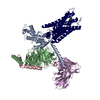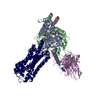[English] 日本語
 Yorodumi
Yorodumi- PDB-9f34: Cryo-EM structure of Dopamine 3 receptor:Go complex bound to bito... -
+ Open data
Open data
- Basic information
Basic information
| Entry | Database: PDB / ID: 9f34 | ||||||
|---|---|---|---|---|---|---|---|
| Title | Cryo-EM structure of Dopamine 3 receptor:Go complex bound to bitopic FOB02-04A - Conformation B | ||||||
 Components Components |
| ||||||
 Keywords Keywords | MEMBRANE PROTEIN / GPCR / complex / bitopic | ||||||
| Function / homology |  Function and homology information Function and homology informationmusculoskeletal movement, spinal reflex action / acid secretion / dopamine neurotransmitter receptor activity, coupled via Gi/Go / response to histamine / adenylate cyclase-inhibiting dopamine receptor signaling pathway / regulation of potassium ion transport / Dopamine receptors / regulation of dopamine uptake involved in synaptic transmission / positive regulation of dopamine receptor signaling pathway / phospholipase C-activating dopamine receptor signaling pathway ...musculoskeletal movement, spinal reflex action / acid secretion / dopamine neurotransmitter receptor activity, coupled via Gi/Go / response to histamine / adenylate cyclase-inhibiting dopamine receptor signaling pathway / regulation of potassium ion transport / Dopamine receptors / regulation of dopamine uptake involved in synaptic transmission / positive regulation of dopamine receptor signaling pathway / phospholipase C-activating dopamine receptor signaling pathway / negative regulation of oligodendrocyte differentiation / mu-type opioid receptor binding / corticotropin-releasing hormone receptor 1 binding / G-protein activation / Activation of the phototransduction cascade / Glucagon-type ligand receptors / Thromboxane signalling through TP receptor / Sensory perception of sweet, bitter, and umami (glutamate) taste / G beta:gamma signalling through PI3Kgamma / G beta:gamma signalling through CDC42 / Cooperation of PDCL (PhLP1) and TRiC/CCT in G-protein beta folding / G protein-coupled receptor internalization / Activation of G protein gated Potassium channels / Inhibition of voltage gated Ca2+ channels via Gbeta/gamma subunits / Ca2+ pathway / G alpha (z) signalling events / High laminar flow shear stress activates signaling by PIEZO1 and PECAM1:CDH5:KDR in endothelial cells / Glucagon-like Peptide-1 (GLP1) regulates insulin secretion / Vasopressin regulates renal water homeostasis via Aquaporins / negative regulation of synaptic transmission, glutamatergic / Adrenaline,noradrenaline inhibits insulin secretion / ADP signalling through P2Y purinoceptor 12 / G alpha (q) signalling events / vesicle docking involved in exocytosis / G alpha (i) signalling events / Thrombin signalling through proteinase activated receptors (PARs) / arachidonate secretion / response to morphine / photoreceptor outer segment membrane / G protein-coupled dopamine receptor signaling pathway / negative regulation of cytosolic calcium ion concentration / spectrin binding / positive regulation of cytokinesis / regulation of heart contraction / alkylglycerophosphoethanolamine phosphodiesterase activity / parallel fiber to Purkinje cell synapse / dopamine metabolic process / regulation of dopamine secretion / social behavior / negative regulation of protein secretion / photoreceptor outer segment / prepulse inhibition / postsynaptic modulation of chemical synaptic transmission / negative regulation of blood pressure / behavioral response to cocaine / cardiac muscle cell apoptotic process / photoreceptor inner segment / adenylate cyclase regulator activity / G protein-coupled serotonin receptor binding / adenylate cyclase-inhibiting serotonin receptor signaling pathway / positive regulation of mitotic nuclear division / negative regulation of phosphatidylinositol 3-kinase/protein kinase B signal transduction / muscle contraction / bioluminescence / learning / response to cocaine / generation of precursor metabolites and energy / circadian regulation of gene expression / locomotory behavior / negative regulation of insulin secretion / G protein-coupled receptor activity / visual learning / GABA-ergic synapse / adenylate cyclase-modulating G protein-coupled receptor signaling pathway / G-protein beta/gamma-subunit complex binding / intracellular calcium ion homeostasis / G beta:gamma signalling through PLC beta / Presynaptic function of Kainate receptors / Thromboxane signalling through TP receptor / Activation of G protein gated Potassium channels / Inhibition of voltage gated Ca2+ channels via Gbeta/gamma subunits / G-protein activation / G beta:gamma signalling through CDC42 / Prostacyclin signalling through prostacyclin receptor / Glucagon signaling in metabolic regulation / G beta:gamma signalling through BTK / ADP signalling through P2Y purinoceptor 12 / Glucagon-type ligand receptors / Adrenaline,noradrenaline inhibits insulin secretion / Vasopressin regulates renal water homeostasis via Aquaporins / Glucagon-like Peptide-1 (GLP1) regulates insulin secretion / G alpha (z) signalling events / ADP signalling through P2Y purinoceptor 1 / cellular response to catecholamine stimulus / ADORA2B mediated anti-inflammatory cytokines production / G beta:gamma signalling through PI3Kgamma / adenylate cyclase-activating dopamine receptor signaling pathway / Cooperation of PDCL (PhLP1) and TRiC/CCT in G-protein beta folding / GPER1 signaling / G-protein beta-subunit binding Similarity search - Function | ||||||
| Biological species |  Homo sapiens (human) Homo sapiens (human)  | ||||||
| Method | ELECTRON MICROSCOPY / single particle reconstruction / cryo EM / Resolution: 3.09 Å | ||||||
 Authors Authors | Arroyo-Urea, S. / Garcia-Nafria, J. | ||||||
| Funding support |  Spain, 1items Spain, 1items
| ||||||
 Citation Citation |  Journal: Nat Commun / Year: 2024 Journal: Nat Commun / Year: 2024Title: A bitopic agonist bound to the dopamine 3 receptor reveals a selectivity site. Authors: Sandra Arroyo-Urea / Antonina L Nazarova / Ángela Carrión-Antolí / Alessandro Bonifazi / Francisco O Battiti / Jordy Homing Lam / Amy Hauck Newman / Vsevolod Katritch / Javier García-Nafría /   Abstract: Although aminergic GPCRs are the target for ~25% of approved drugs, developing subtype selective drugs is a major challenge due to the high sequence conservation at their orthosteric binding site. ...Although aminergic GPCRs are the target for ~25% of approved drugs, developing subtype selective drugs is a major challenge due to the high sequence conservation at their orthosteric binding site. Bitopic ligands are covalently joined orthosteric and allosteric pharmacophores with the potential to boost receptor selectivity and improve current medications by reducing off-target side effects. However, the lack of structural information on their binding mode impedes rational design. Here we determine the cryo-EM structure of the hDR:Gαβγ complex bound to the DR selective bitopic agonist FOB02-04A. Structural, functional and computational analyses provide insights into its binding mode and point to a new TM2-ECL1-TM1 region, which requires the N-terminal ordering of TM1, as a major determinant of subtype selectivity in aminergic GPCRs. This region is underexploited in drug development, expands the established secondary binding pocket in aminergic GPCRs and could potentially be used to design novel and subtype selective drugs. | ||||||
| History |
|
- Structure visualization
Structure visualization
| Structure viewer | Molecule:  Molmil Molmil Jmol/JSmol Jmol/JSmol |
|---|
- Downloads & links
Downloads & links
- Download
Download
| PDBx/mmCIF format |  9f34.cif.gz 9f34.cif.gz | 221.2 KB | Display |  PDBx/mmCIF format PDBx/mmCIF format |
|---|---|---|---|---|
| PDB format |  pdb9f34.ent.gz pdb9f34.ent.gz | Display |  PDB format PDB format | |
| PDBx/mmJSON format |  9f34.json.gz 9f34.json.gz | Tree view |  PDBx/mmJSON format PDBx/mmJSON format | |
| Others |  Other downloads Other downloads |
-Validation report
| Summary document |  9f34_validation.pdf.gz 9f34_validation.pdf.gz | 1.3 MB | Display |  wwPDB validaton report wwPDB validaton report |
|---|---|---|---|---|
| Full document |  9f34_full_validation.pdf.gz 9f34_full_validation.pdf.gz | 1.3 MB | Display | |
| Data in XML |  9f34_validation.xml.gz 9f34_validation.xml.gz | 40.6 KB | Display | |
| Data in CIF |  9f34_validation.cif.gz 9f34_validation.cif.gz | 60.6 KB | Display | |
| Arichive directory |  https://data.pdbj.org/pub/pdb/validation_reports/f3/9f34 https://data.pdbj.org/pub/pdb/validation_reports/f3/9f34 ftp://data.pdbj.org/pub/pdb/validation_reports/f3/9f34 ftp://data.pdbj.org/pub/pdb/validation_reports/f3/9f34 | HTTPS FTP |
-Related structure data
| Related structure data |  50169MC  9f33C M: map data used to model this data C: citing same article ( |
|---|---|
| Similar structure data | Similarity search - Function & homology  F&H Search F&H Search |
- Links
Links
- Assembly
Assembly
| Deposited unit | 
|
|---|---|
| 1 |
|
- Components
Components
-Guanine nucleotide-binding protein ... , 3 types, 3 molecules ABC
| #1: Protein | Mass: 40097.500 Da / Num. of mol.: 1 / Mutation: S47N,G204A,E246A,M249K,A326S Source method: isolated from a genetically manipulated source Source: (gene. exp.)  Homo sapiens (human) / Gene: GNAO1 / Production host: Homo sapiens (human) / Gene: GNAO1 / Production host:  Trichoplusia ni (cabbage looper) / References: UniProt: P09471 Trichoplusia ni (cabbage looper) / References: UniProt: P09471 |
|---|---|
| #2: Protein | Mass: 39373.992 Da / Num. of mol.: 1 Source method: isolated from a genetically manipulated source Source: (gene. exp.)   Trichoplusia ni (cabbage looper) / References: UniProt: P54311 Trichoplusia ni (cabbage looper) / References: UniProt: P54311 |
| #3: Protein | Mass: 7845.078 Da / Num. of mol.: 1 / Mutation: C68S Source method: isolated from a genetically manipulated source Source: (gene. exp.)  Homo sapiens (human) / Gene: GNG2 / Production host: Homo sapiens (human) / Gene: GNG2 / Production host:  Trichoplusia ni (cabbage looper) / References: UniProt: P59768 Trichoplusia ni (cabbage looper) / References: UniProt: P59768 |
-Antibody / Protein / Non-polymers , 3 types, 3 molecules ER
| #4: Antibody | Mass: 27625.844 Da / Num. of mol.: 1 Source method: isolated from a genetically manipulated source Source: (gene. exp.)   Trichoplusia ni (cabbage looper) Trichoplusia ni (cabbage looper) |
|---|---|
| #5: Protein | Mass: 74733.945 Da / Num. of mol.: 1 / Mutation: L119W Source method: isolated from a genetically manipulated source Details: HASS-FLAG-eGFP-D3R,HASS-FLAG-eGFP-D3R,HASS-FLAG-eGFP-D3R,HASS-FLAG-eGFP-D3R,HASS-FLAG-eGFP-D3R,HASS-FLAG-eGFP-D3R,HASS-FLAG-eGFP-D3R,HASS-FLAG-eGFP-D3R,HASS-FLAG-eGFP-D3R,HASS-FLAG-eGFP- ...Details: HASS-FLAG-eGFP-D3R,HASS-FLAG-eGFP-D3R,HASS-FLAG-eGFP-D3R,HASS-FLAG-eGFP-D3R,HASS-FLAG-eGFP-D3R,HASS-FLAG-eGFP-D3R,HASS-FLAG-eGFP-D3R,HASS-FLAG-eGFP-D3R,HASS-FLAG-eGFP-D3R,HASS-FLAG-eGFP-D3R,HASS-FLAG-eGFP-D3R,HASS-FLAG-eGFP-D3R,HASS-FLAG-eGFP-D3R,HASS-FLAG-eGFP-D3R,HASS-FLAG-eGFP-D3R,HASS-FLAG-eGFP-D3R,HASS-FLAG-eGFP-D3R,HASS-FLAG-eGFP-D3R,HASS-FLAG-eGFP-D3R,HASS-FLAG-eGFP-D3R,HASS-FLAG-eGFP-D3R,HASS-FLAG-eGFP-D3R,HASS-FLAG-eGFP-D3R,HASS-FLAG-eGFP-D3R,HASS-FLAG-eGFP-D3R,HASS-FLAG-eGFP-D3R,HASS-FLAG-eGFP-D3R,HASS-FLAG-eGFP-D3R,HASS-FLAG-eGFP-D3R,HASS-FLAG-eGFP-D3R,HASS-FLAG-eGFP-D3R,HASS-FLAG-eGFP-D3R,HASS-FLAG-eGFP-D3R,HASS-FLAG-eGFP-D3R,HASS-FLAG-eGFP-D3R,HASS-FLAG-eGFP-D3R,HASS-FLAG-eGFP-D3R,HASS-FLAG-eGFP-D3R,HASS-FLAG-eGFP-D3R,HASS-FLAG-eGFP-D3R,HASS-FLAG-eGFP-D3R,HASS-FLAG-eGFP-D3R,HASS-FLAG-eGFP-D3R,HASS-FLAG-eGFP-D3R,HASS-FLAG-eGFP-D3R,HASS-FLAG-eGFP-D3R,HASS-FLAG-eGFP-D3R,HASS-FLAG-eGFP-D3R,HASS-FLAG-eGFP-D3R,HASS-FLAG-eGFP-D3R,HASS-FLAG-eGFP-D3R,HASS-FLAG-eGFP-D3R,HASS-FLAG-eGFP-D3R,HASS-FLAG-eGFP-D3R,HASS-FLAG-eGFP-D3R,HASS-FLAG-eGFP-D3R,HASS-FLAG-eGFP-D3R,HASS-FLAG-eGFP-D3R,HASS-FLAG-eGFP-D3R,HASS-FLAG-eGFP-D3R,HASS-FLAG-eGFP-D3R,HASS-FLAG-eGFP-D3R,HASS-FLAG-eGFP-D3R,HASS-FLAG-eGFP-D3R Source: (gene. exp.)  Homo sapiens (human) / Gene: GFP, DRD3 / Production host: Homo sapiens (human) / Gene: GFP, DRD3 / Production host:  Trichoplusia ni (cabbage looper) / References: UniProt: P42212, UniProt: P35462 Trichoplusia ni (cabbage looper) / References: UniProt: P42212, UniProt: P35462 |
| #6: Chemical | ChemComp-A1H9N / Mass: 433.546 Da / Num. of mol.: 1 / Source method: obtained synthetically / Formula: C25H31N5O2 / Feature type: SUBJECT OF INVESTIGATION |
-Details
| Has ligand of interest | Y |
|---|---|
| Has protein modification | Y |
-Experimental details
-Experiment
| Experiment | Method: ELECTRON MICROSCOPY |
|---|---|
| EM experiment | Aggregation state: PARTICLE / 3D reconstruction method: single particle reconstruction |
- Sample preparation
Sample preparation
| Component | Name: D3R: Gtrimer: scFv16 complex bound to the bitopic FOB02-04A - Conformation B Type: COMPLEX / Entity ID: #1-#5 / Source: RECOMBINANT |
|---|---|
| Molecular weight | Value: 0.19 MDa / Experimental value: NO |
| Source (natural) | Organism:  Homo sapiens (human) Homo sapiens (human) |
| Source (recombinant) | Organism:  Trichoplusia ni (cabbage looper) Trichoplusia ni (cabbage looper) |
| Buffer solution | pH: 7.4 |
| Specimen | Conc.: 2.8 mg/ml / Embedding applied: NO / Shadowing applied: NO / Staining applied: NO / Vitrification applied: YES |
| Specimen support | Grid material: GOLD / Grid mesh size: 300 divisions/in. / Grid type: Quantifoil R0.6/1 |
| Vitrification | Instrument: FEI VITROBOT MARK IV / Cryogen name: ETHANE / Humidity: 100 % / Chamber temperature: 277 K |
- Electron microscopy imaging
Electron microscopy imaging
| Experimental equipment |  Model: Titan Krios / Image courtesy: FEI Company |
|---|---|
| Microscopy | Model: FEI TITAN KRIOS |
| Electron gun | Electron source:  FIELD EMISSION GUN / Accelerating voltage: 300 kV / Illumination mode: FLOOD BEAM FIELD EMISSION GUN / Accelerating voltage: 300 kV / Illumination mode: FLOOD BEAM |
| Electron lens | Mode: BRIGHT FIELD / Nominal defocus max: 3000 nm / Nominal defocus min: 1000 nm / Cs: 2.7 mm / C2 aperture diameter: 50 µm / Alignment procedure: COMA FREE |
| Specimen holder | Cryogen: NITROGEN / Specimen holder model: FEI TITAN KRIOS AUTOGRID HOLDER |
| Image recording | Electron dose: 50 e/Å2 / Detector mode: SUPER-RESOLUTION / Film or detector model: GATAN K3 (6k x 4k) / Num. of real images: 22655 |
| Image scans | Movie frames/image: 50 |
- Processing
Processing
| EM software |
| ||||||||||||||||||||||||||||||||
|---|---|---|---|---|---|---|---|---|---|---|---|---|---|---|---|---|---|---|---|---|---|---|---|---|---|---|---|---|---|---|---|---|---|
| CTF correction | Type: PHASE FLIPPING AND AMPLITUDE CORRECTION | ||||||||||||||||||||||||||||||||
| Particle selection | Num. of particles selected: 19414230 | ||||||||||||||||||||||||||||||||
| 3D reconstruction | Resolution: 3.09 Å / Resolution method: FSC 0.143 CUT-OFF / Num. of particles: 159184 / Symmetry type: POINT | ||||||||||||||||||||||||||||||||
| Atomic model building | Protocol: OTHER / Space: REAL | ||||||||||||||||||||||||||||||||
| Refine LS restraints |
|
 Movie
Movie Controller
Controller



 PDBj
PDBj























